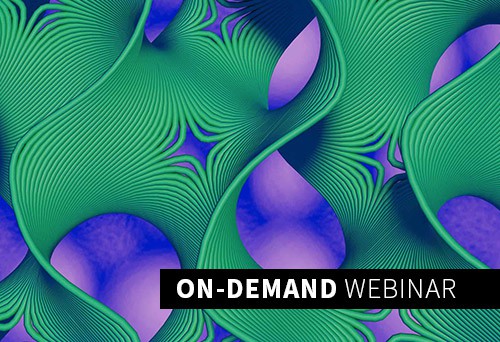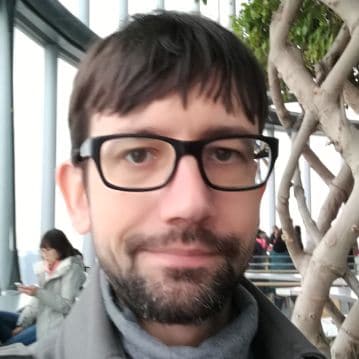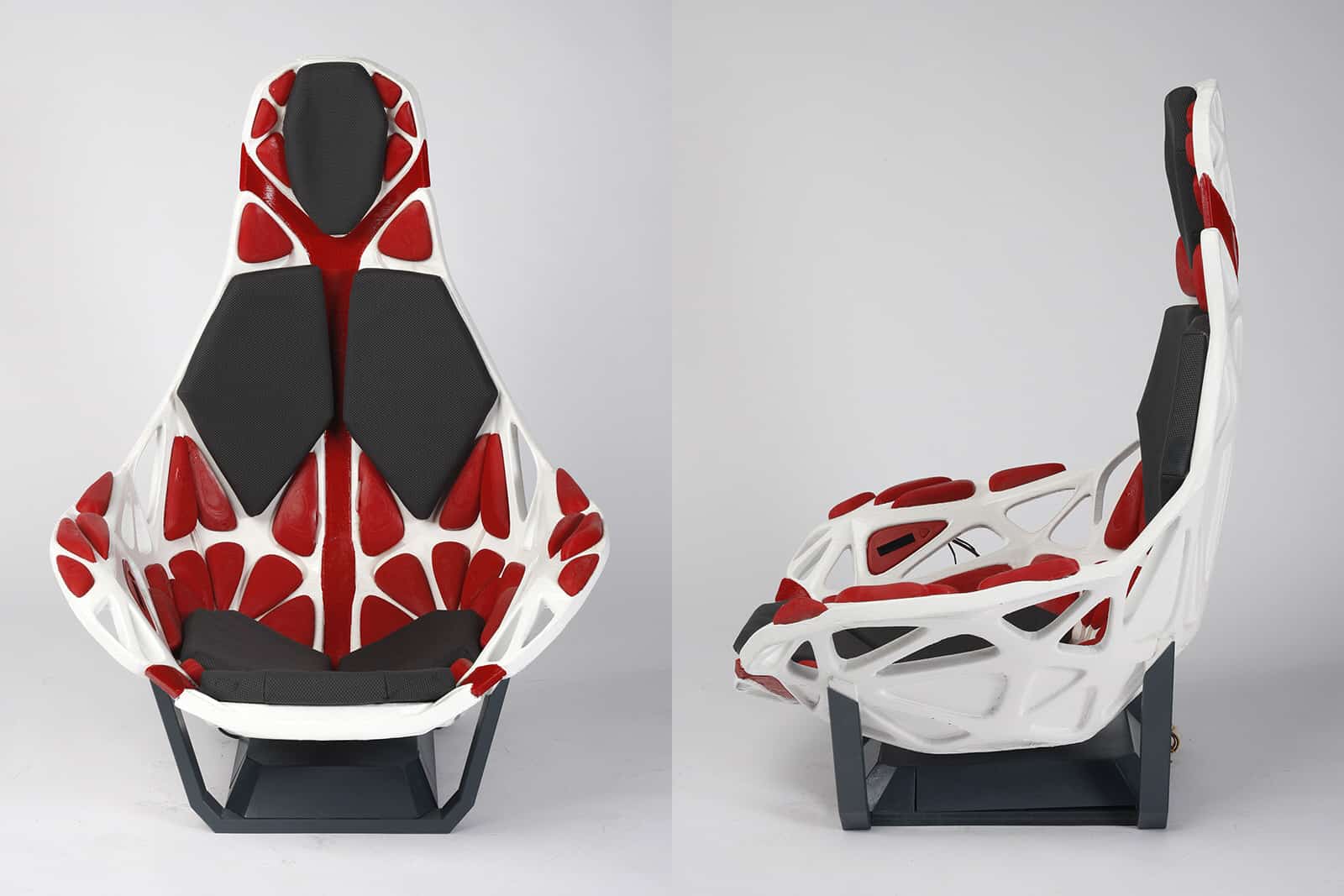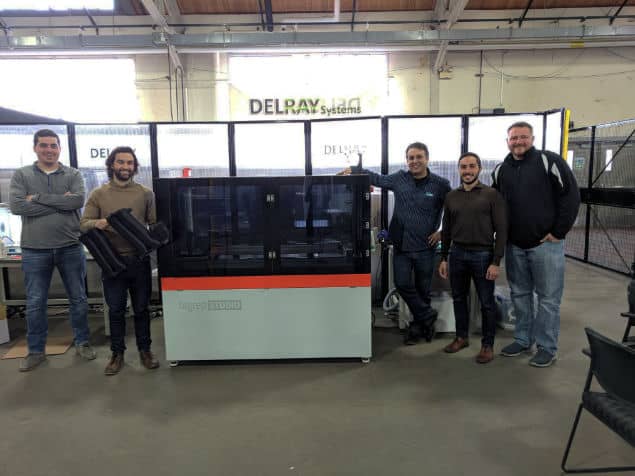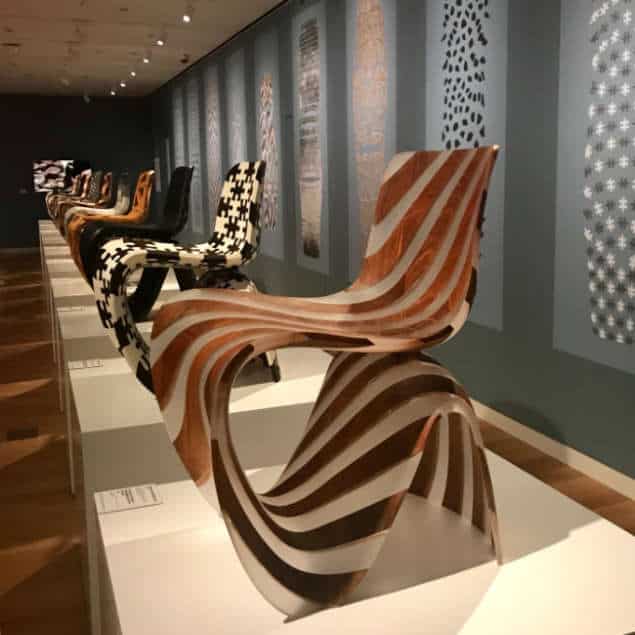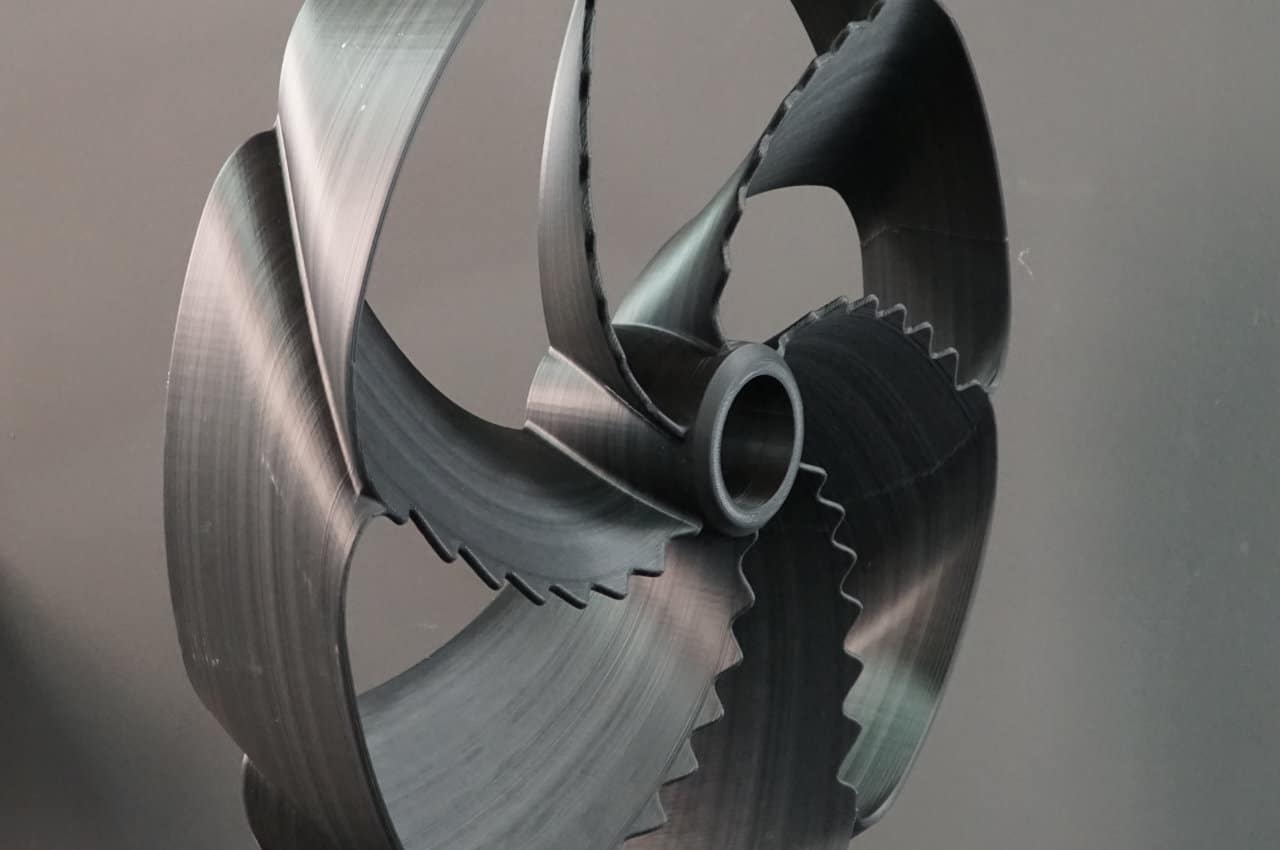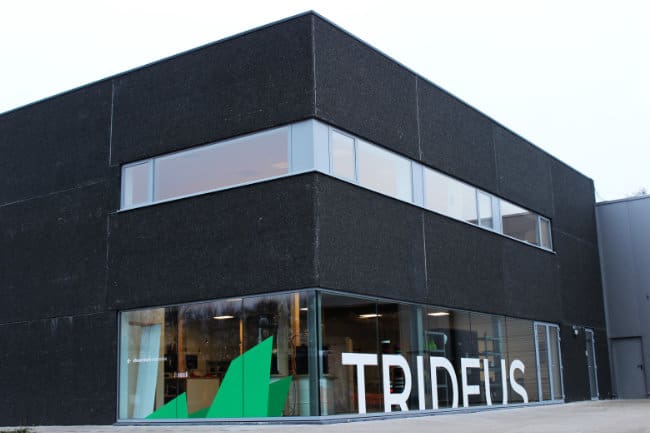- New Features
- Hide job upload for offline printers
- CRM synchronization
- Bug Fixes
- Menu overflow
The Power of Gyroid Infill in 3D Printing: Strength, Efficiency, Precision
Improve your 3D prints with gyroid infill, a structure that strengthens, lightens, and enhances design. This guide covers benefits, strategies, and applications to help you achieve the best results.
You'll learn:
- What is gyroid infill?
- Advantages of gyroid infill
- How to use gyroid infill
What is a Gyroid?
A gyroid is a fascinating mathematical shape known as a triply periodic minimal surface. It was discovered by physicist Alan Schoen in 1970 and has since become a popular infill pattern in 3D printing.
To understand a gyroid, imagine a complex network of twisted and interconnected tubes. These tubes form a repeating pattern that extends infinitely in all directions without intersecting or overlapping. The result is a continuous lattice structure that fills up space in a unique and captivating way.
The gyroid pattern exhibits a remarkable balance between complexity and symmetry. It features self-replicating motifs that create an intricate and interconnected lattice. This intricate geometry is what gives gyroid infill its exceptional properties.
While understanding the mathematical intricacies of a gyroid can be complex, 3D printing software simplifies the process of creating this pattern automatically. By leveraging the power of intelligent 3D printing software, you can easily implement gyroid infill and harness its unique properties for your 3D prints.

Understanding Gyroid Infill:
The gyroid infill pattern is renowned for its exceptional strength-to-weight ratio. Due to its intricate interlocking geometry, it provides excellent load-bearing capabilities, making it ideal for parts that require durability and resilience. Whether you're prototyping functional components or creating intricate art pieces, gyroid infill ensures that your prints can withstand the test of time.
In addition to its strength, gyroid infill is known for its material efficiency. By utilizing its interconnected channels, it reduces material usage without compromising structural integrity. This characteristic is particularly advantageous when printing larger objects that can become overly heavy and use large amounts of material or when cost-effective production is a priority. With gyroid infill, you can achieve lightweight 3D prints while minimizing waste, making it an eco-friendly choice for sustainable manufacturing practices.
Gyroid infill is a great choice for creating visually appealing 3D prints, thanks to its intricate and organic pattern. The interlocking tubes create a mesmerizing visual effect that adds a unique touch to your 3D prints. This can be particularly striking in 3D prints that are sliced without perimeter walls, making the gyroid infill fully visible.
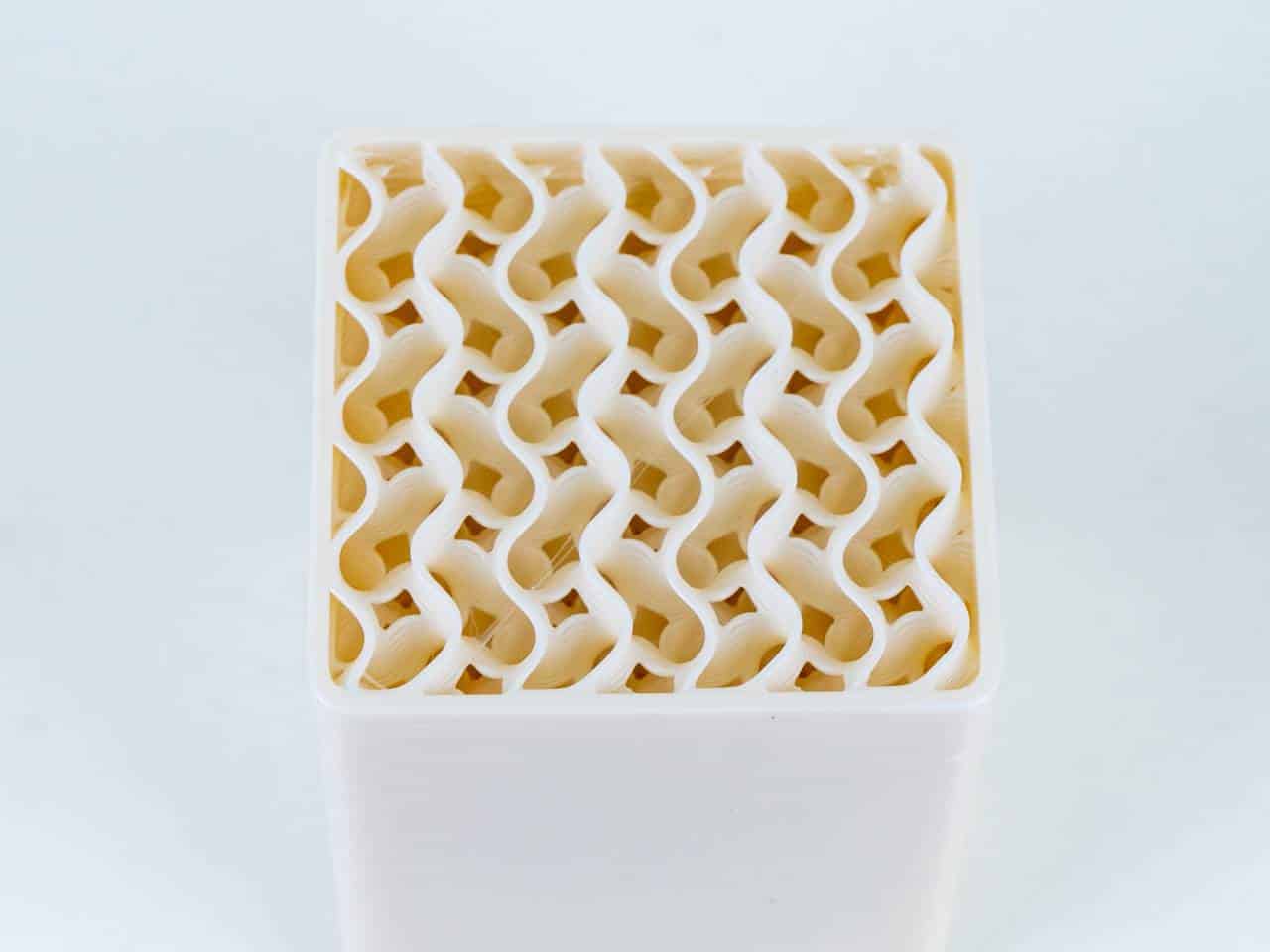
Advantages of Gyroid Infill in 3D Printing:
Low warping:
Unlike other infill patterns, the curved lines of the gyroid infill do not provide a specific direction for plastic shrinkage. This unique characteristic helps to distribute the stresses and forces evenly throughout the print, reducing the likelihood of warping. Eliminating the directional bias enhances the overall stability and dimensional accuracy of 3D printed objects.
Enhanced Strength and Structural Integrity:
Gyroid infill exhibits exceptional strength and structural integrity due to its interlocking lattice structure. The complex network of interconnected channels distributes forces evenly throughout the print, minimizing the risk of failure and improving overall stability. This makes gyroid infill suitable for load-bearing applications that require durability and resistance to external forces.
Significant Weight Reduction:
One of the standout advantages of gyroid infill is its ability to achieve significant weight reduction in 3D printed objects. The intricate lattice structure optimizes material usage, creating a lightweight yet robust internal framework.
Material Efficiency and Cost Savings:
Gyroid infill is highly efficient in terms of material usage. The interconnected channels and intricate lattice pattern reduce the volume of material required for the infill, minimizing material waste and lowering costs. This is particularly valuable when working with expensive or high-volume materials, as gyroid infill maximizes material efficiency without compromising strength or structural integrity.
Improved Heat Dissipation:
The gyroid lattice structure provides excellent heat dissipation properties. The interconnected channels allow for efficient airflow, aiding in the cooling process during printing. Improved heat dissipation helps prevent warping, deformation, or other thermal issues, resulting in more reliable and dimensionally accurate prints.
Enhanced Flexibility and Impact Resistance:
The intricate lattice structure of gyroid infill offers a unique advantage in terms of flexibility and impact resistance. The interlocking nature of the lattice allows for controlled flexing and absorption of energy upon impact, making 3D printed parts more resistant to breaking or cracking. This property is beneficial for parts that undergo stress or require a certain degree of flexibility, such as protective cases, sports equipment, or wearable accessories.
Excellent Filament Flow:
The gyroid infill pattern facilitates smooth and consistent filament flow during printing. The continuous, interconnected channels enable efficient material distribution, reducing the chances of clogs or inconsistent extrusion. This results in improved 3D print quality, accuracy, and reliability, contributing to successful prints with fewer defects or issues.
By leveraging these advantages, gyroid infill unlocks new possibilities in 3D printing, allowing for stronger, lighter, more cost-effective, and visually appealing prints.
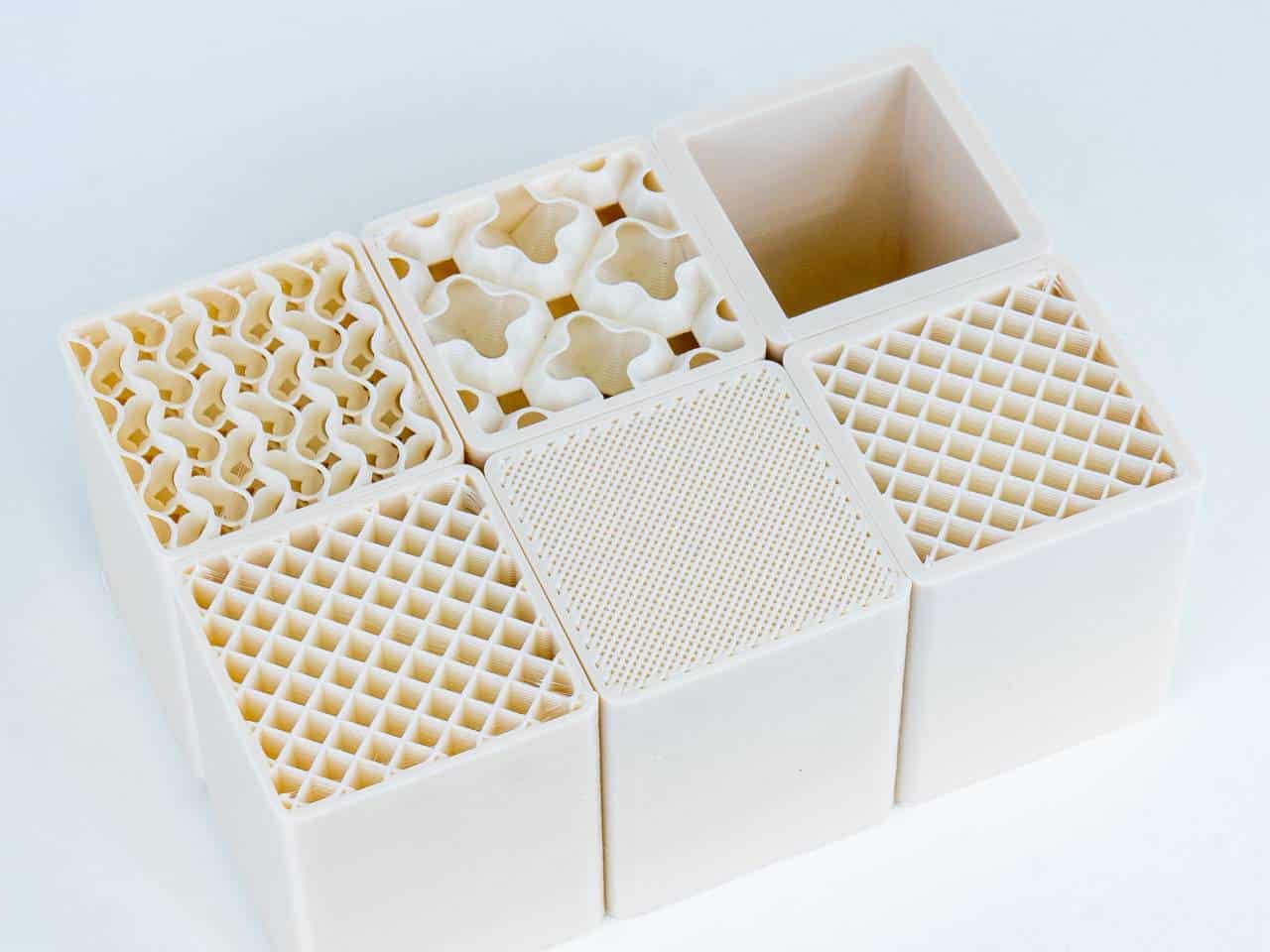
Disadvantages of Gyroid Infill in 3D Printing:
While gyroid infill offers numerous advantages, it is important to consider its potential disadvantages as well:
Longer Slicing Times
Each layer must be meticulously computed and mapped to the interlocking channels of the gyroid infill. Consequently, the slicing software needs to process more data and perform additional computations, resulting in longer slicing times.
Limited Control Over Internal Geometry:
The complex nature of the gyroid grid can make it difficult to incorporate specific internal features or structures into the print. Unlike lattice infill patterns, gyroid infill may limit the ability to create precise internal geometries or incorporate functional features such as internal channels or compartments. If your print requires precise internal designs or specific functionality, gyroid infill may not be the best option.
Reduced Transparency and Visual Clarity:
If transparency or visual clarity is desired in your print, gyroid infill may not be the best choice. The complex structure of gyroid infill can obstruct light transmission and result in reduced transparency. This limitation may not be suitable for applications that require optical clarity or the ability to see through the 3D printed object.
Understanding these potential disadvantages will help you make informed decisions when choosing infill patterns for your 3D prints.
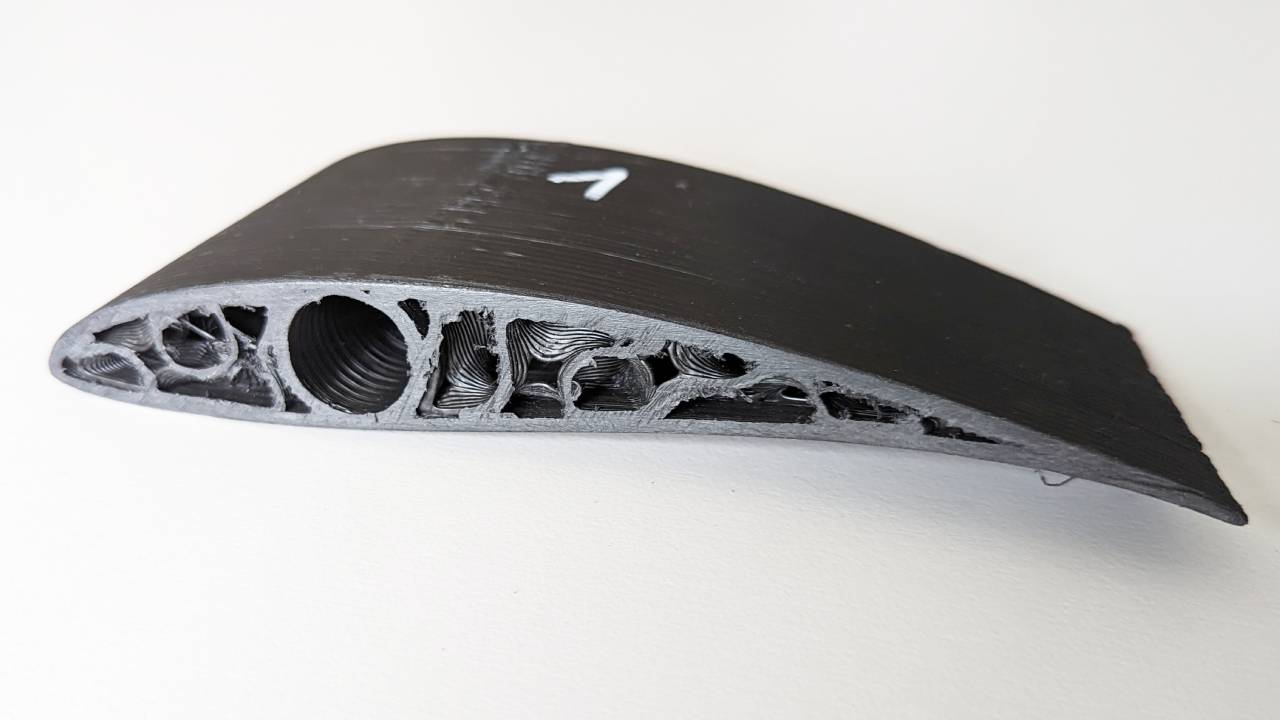
Applications and Use Cases:
The versatility of gyroid infill opens up a wide range of applications and use cases where its unique properties shine. Here are a few areas where gyroid infill has proven to be particularly advantageous:
Functional Prototypes:
When creating prototypes for functional testing, gyroid infill offers the perfect balance of strength, weight reduction, and material efficiency. It ensures that prototypes can withstand rigorous testing while minimizing material costs.
Mechanical Components:
Parts that require durability, stability, and resistance to external forces benefit greatly from gyroid infill. Whether it's gears, brackets, or structural supports, gyroid infill enhances the overall performance and longevity of these components.
Lightweight Structures:
Industries such as aerospace, automotive, and robotics often require lightweight components to improve performance and efficiency. Gyroid infill helps achieve these goals by reducing weight without compromising strength or structural integrity.
Artistic and Decorative Prints:
The visually captivating nature of gyroid infill makes it an excellent choice for artistic and decorative prints. From intricate sculptures to visually appealing art pieces, gyroid infill adds a unique aesthetic dimension to the finished prints.
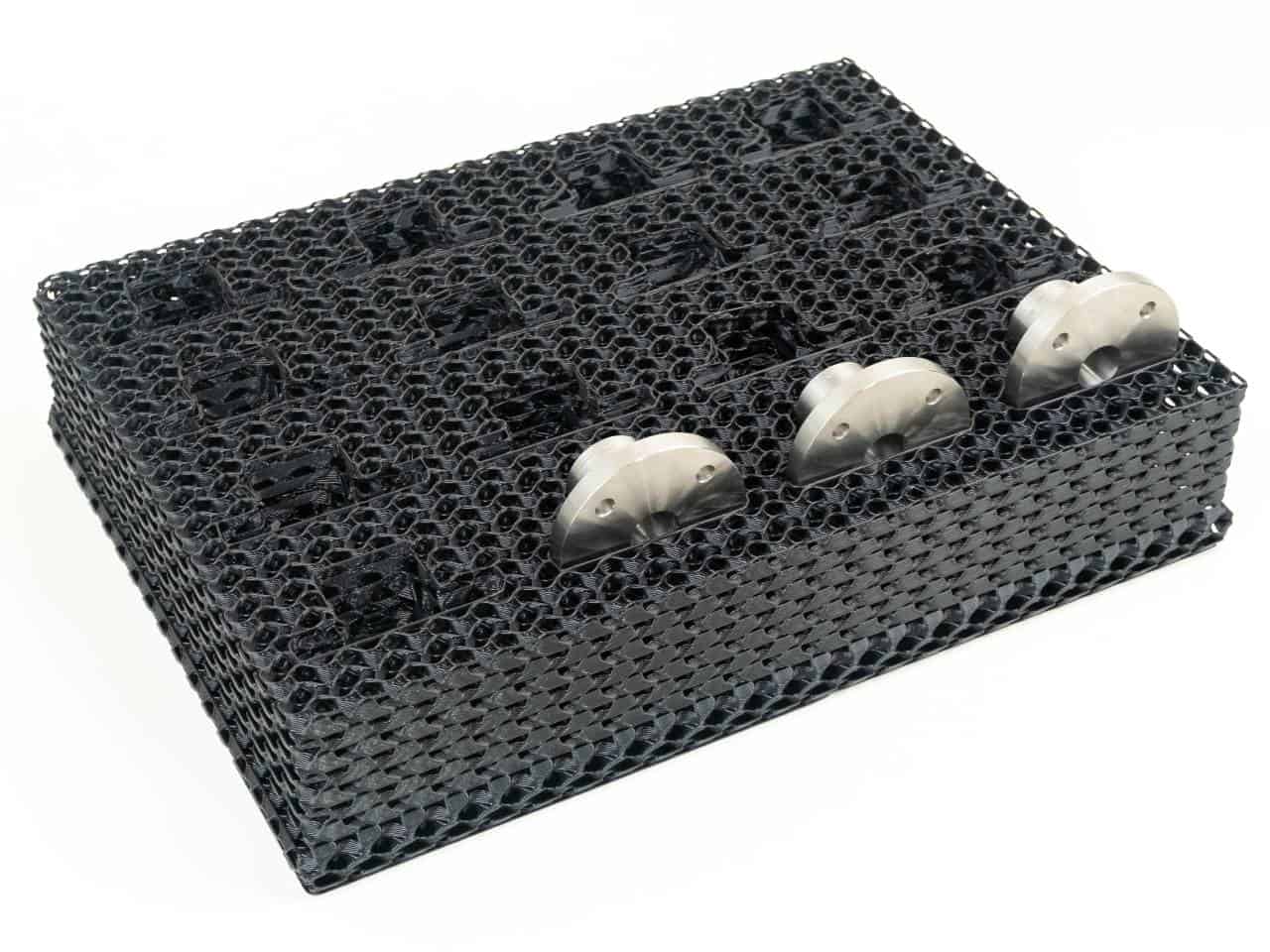
Implementation and Tips for Using Gyroid Infill:
Now that we have explored the advantages and disadvantages of gyroid infill, let's delve into its implementation and some tips for achieving the best results:
- Software and Slicer Settings:
To utilize gyroid infill effectively, ensure that your 3D printing software and slicer support this infill pattern. Most popular slicing software, such as Cura, Simplify3D, or BigRep BLADE, provide gyroid infill as an option. Select the gyroid infill pattern and adjust the infill density according to your requirements. Experimenting with different densities can help find the optimal balance between strength and material usage. - Print Orientation:
Consider the orientation of your print when using gyroid infill. The orientation can affect the strength and overall performance of the 3D printed object. For parts that require enhanced strength in a specific direction, orient the print accordingly. Testing and analyzing the load-bearing capabilities in different orientations can help optimize the performance of your prints. - Infill Density:
The density of gyroid infill determines the amount of material used and impacts the structural integrity of the print. Higher infill densities result in stronger prints but require more material. Conversely, lower infill densities reduce material usage but may sacrifice some strength. Finding the right balance between infill density and material efficiency is crucial. Consider the specific requirements of your print to determine the optimal infill density. - Experiment and Iterate:
As with any 3D printing technique, it is essential to experiment, iterate, and test your prints. Adjust the infill density, print orientation, and other parameters to find the optimal settings for your specific application. This iterative approach will help you fine-tune your prints and achieve the desired balance between strength, weight reduction, and aesthetics.
Conclusion:
Gyroid infill offers a multitude of advantages in 3D printing, including
- enhanced strength,
- significant weight reduction,
- material efficiency,
- improved print quality,
- and versatile applications.
Its interlocking structure provides superior structural integrity, making it ideal for functional prototypes, mechanical components, and lightweight structures.
To leverage gyroid infill effectively, ensure that your software and slicer support this infill pattern, and adjust the infill density and print orientation to meet your specific requirements.
Experimentation, testing, and iteration are key to achieving optimal results with gyroid infill.
Utilizing gyroid infill can significantly enhance the strength, efficiency, and appearance of your 3D printed objects. Regardless of whether you are a hobbyist, engineer, or designer, incorporating gyroid infill in your 3D printing process can unlock new opportunities and enable innovative applications.
Want to Learn More About Gyroid Infill?
Explore the innovative use of gyroid structures in wind turbine manufacturing and biomedical applications with expert Jörg Alber from TU Berlin. Don't miss out, watch the webinar now:
THE 3D-PRINTED GYROID: IMPROVING STRUCTURALLY DEMANDING APPLICATIONS
About the author:
Students Bring “Breathing” Audi Car Seat to Life with 3D Printing
Responsive car seat enabled by large-format 3D printing showcases innovation potential for additive manufacturing in the automotive space.
While the focus is often on engine power and exterior design when talking about cars, there is another automotive feature ripe for innovation. The car seat, which functions as the interface between driver and vehicle, is one of the most important elements of a car and must offer ergonomic support, safety features, and comfort.
In recent years, there has been a growing focus on how to reinvent and improve automotive seating using new design concepts and advanced manufacturing, such as 3D printing. One such project, entitled “Concept Breathe”, was the result of a collaboration between students at the Braunschweig University of Art, German automotive manufacturer Audi, and large-format 3D printing specialist BigRep.
A Multi-Partner Effort
Concept Breathe, which culminated in the creation of a full-sized “breathable” car seat, was born out of an exploration into the car of the future. The Braunschweig design students, under the supervision of Dr. Manuel Kretzer, a professor of Material and Technology, and Audi’s development/innovation unit led by Mike Herbig, were inspired by the idea that the car of the future could have a greater connection to the driver. As they say: “What if it were to become a partner that reacts and responds to our actions, an organism, a friend, that lives and breathes?”
Interestingly, Audi had already started pursuing this idea with the development of Klara, a “sensitive Audi A1” in 2017. This concept study aimed to foster greater empathy between automobile and driver by creating a sensitive car that appears to breathe. The breathing effect was the result of 39 electric motors installed under the car’s metalwork and several sensors that would enable Klara to take breaths and react to its surroundings.
The Concept Breathe car seat project, undertaken in the spring of 2017, was an extension of the experimental Klara initiative that sought to combine different technologies and design principles to create a more human car seat that could dynamically move along with the driver.
“What if the seat were to become a partner that reacts and responds to our actions, an organism, a friend, that lives and breathes?”
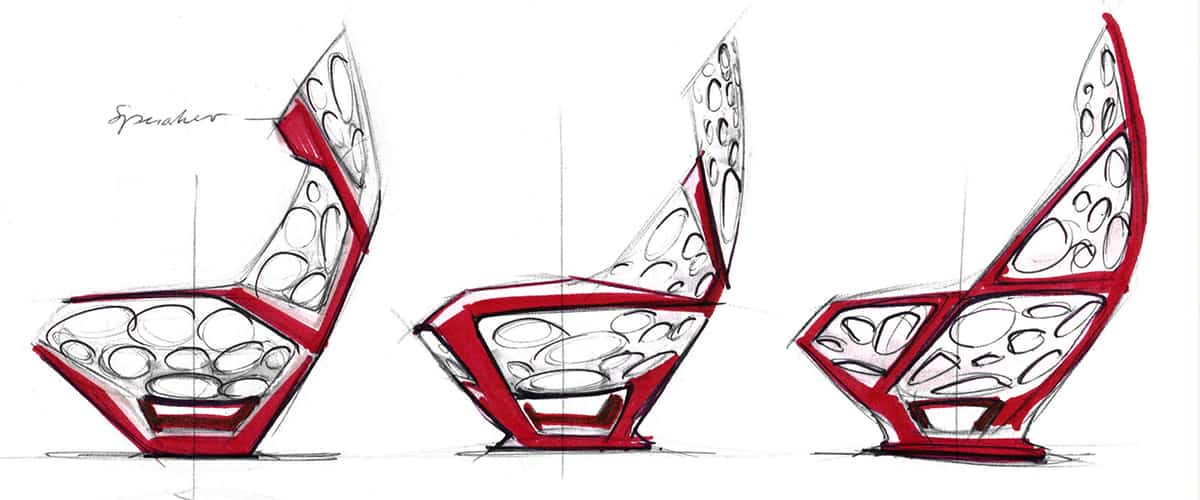
Conceiving of ‘Concept Breathe’
The seating project was spearheaded by a group of 10 bachelor students at the Braunschweig University of Art as part of their Digital Crafting module. The courses in this module are specifically aimed at developing “an experimental understanding of emerging design opportunities” by leveraging innovative algorithmic and parametric design principles, as well as digital manufacturing technologies, such as 3D printing, which bring design concepts to life.
Ultimately, the car seat’s design was inspired by organic shapes and systems and consisted of several active components integrated into a lightweight frame. Due to the final design’s complex geometry—which was the result of several parametrically designed iterations—the student team and their partners decided to 3D print the 1:1 seat prototype. BigRep, known for its large-scale 3D printers, was more than up to the task.
The seat structure was 3D printed using the BigRep ONE machine, which has a large build volume of up to one cubic meter, and BigRep’s PRO HT filament, an easy-to-print biopolymer with enhanced temperature resistance compared to traditional PLA. The printing process took nearly 10 days to complete, which at the time marked BigRep’s longest print.
Onto the 3D printed frame were attached 38 customized active components, which created a haptic and visual breathing effect, along with a range of specially designed cushions made from a high-performance textile for optimized comfort and support. As the design team put it: the active components (seen in red) “are designed to increase the seat's ability to respond to changing driving conditions but especially to enhance the user's identification with the animate object through motions of breathing.”
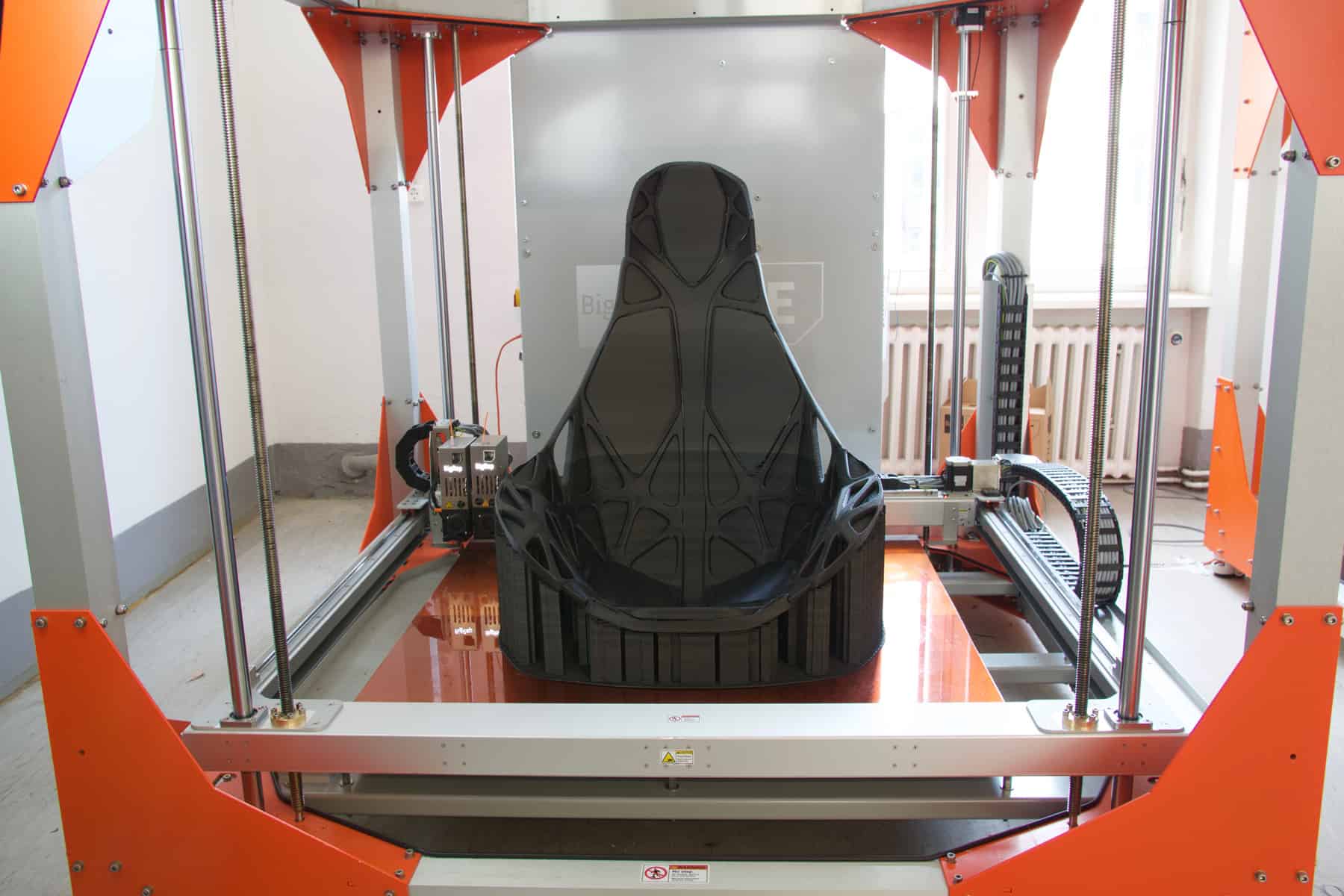
Paving the Way for Innovation
BigRep’s 3D printing technology was vital to the realization of the project. Not only was the company’s large-format 3D printer equipped to handle the scale of the full-sized car seat structure (reducing the need for post-printing assembly), it was also able to reproduce the product’s complex organic shape. Moreover, 3D printing offered the project partners a cost-accessible way to directly create a large prototype without having to invest in tooling or turn to complex supply chains.
In the same way that large-format 3D printing was critical to bringing this concept design to life, the technology is now being used across the automotive industry to explore new design ideas and bring new innovative solutions to market, from rapid prototypes to end-use parts. In automotive seating applications in particular, there have been a number of projects that leverage the technology’s ability to create complex designs optimized for performance and comfort, as well as customized products at scale.
Similarly, German automaker Porsche recently launched a 3D printed bodyform full-bucket seat that integrates customizable 3D printed lattices for superior support and breathability. Much like Concept Breathe, the 3D printed seat emphasizes the human and technology connection to generate an enhanced driving experience, particularly for high-performance vehicles.
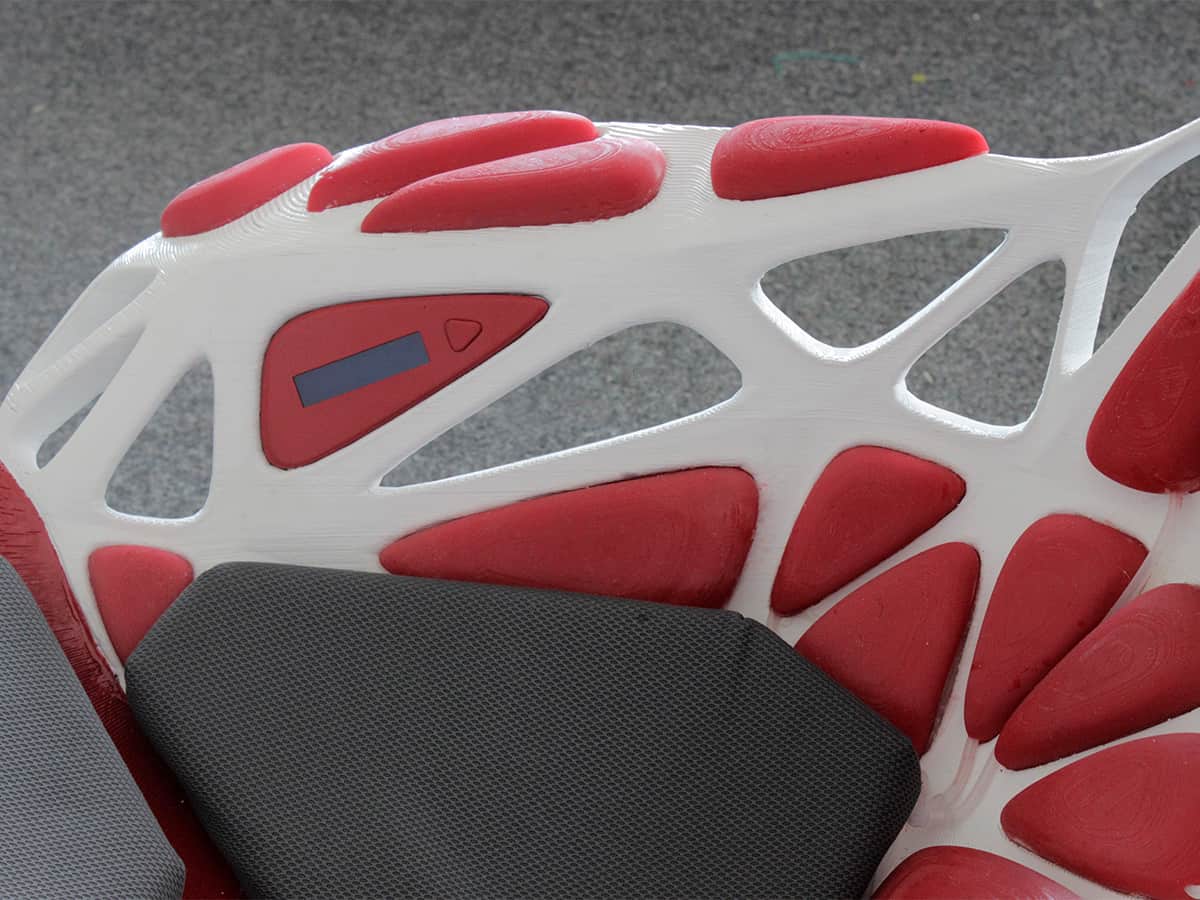
3D Printing is the Future of Automotive
Ultimately, the Concept Breathe project would not have been possible without additive manufacturing, particularly BigRep’s large-format 3D printing. The technology proved to be essential for rapidly and cost-effectively bringing an innovative idea to life.
For the broader automotive industry, the ability to 3D print large structures and products in a single piece has huge benefits. For one, it allows for design consolidation, allowing for large structures to be printed in one go, minimizing assembly and post-processing times. This has significant time and cost impacts whether users are printing a design concept, a functional prototype, or an end-use part.
The technology also enables product designers to create previously impossible designs, opening up limitless opportunities for innovation. With it, forward-thinking individuals and teams (such as the Braunschweig design students and their partners at Audi and BigRep) can really dive into new ideas and transform them into something real, something that can shape the future.
To learn more about how 3D printing helped bring the Concept Breathe article to life, check out the following video and the original coverage of the project.
Interested in how the BigRep ONE can unlock your innovation? Learn more about large-scale printing here.
CONNECT 06/23 Released!
- New Features
- Live USB webcam stream (requires ONE/STUDIO HMI 1.5.9)
- Remote print start/pause/stop/resume (requires ONE/STUDIO HMI 1.6.0)
- Remote bed preheat/cooldown (requires ONE/STUDIO HMI 1.6.0)
- Affiliation management
- Heating indicator
- Bug Fixes
- Calculated print progress not reliable
BLADE 3.6.0 Released!
- Update to Cura 4.13
- Improved UI
- Exported projects now contain a thumbnail
- Improved seam placement
- Improved theme
- PRO.1
- JUMPSTART Upgrade Kit support: Custom material profiles depending on the selected print surface
- Polyimide (not upgraded)
- SWITCHPLATE (after JUMPSTART upgrade)
- Layer height can be changed manually
- New material profile: TPU
- Improved material profile: PA6/66
- Improved profile: HI-TEMP-CF
- Added 0.2mm layer height for ACE 0.6mm
- JUMPSTART Upgrade Kit support: Custom material profiles depending on the selected print surface
- PRO.2
- Improved overall performance and print quality
- Layer height can be changed manually
- Improved profile: PA6/66
- Improved material profile: HI-TEMP-CF
- Added 0.2mm layer height for ACE 0.6mm
- Improved profile: PETG
- Added 0.2mm layer height for ACE 0.6mm
- Improved material profile: TPU
New Tech in an Old Manufacturing Town – Detroit’s 3D Printing Experts DELRAY Systems
In knowing what Mid-West manufacturers need to gain a competitive edge, DELRAY Systems is in arguably the best position possible. Its Founder Joe Rocca’s was himself an early adopter in the 3D printing industry and knows how important it is to be leading the field with the latest additive manufacturing technology.
“Since 1996, technology has changed substantially,” said Rocca, reflecting on the time he moved into the 3D printing sphere. “3D printing machines were very expensive back then.” Not only has the industry technology changed; so too has the way companies do business and the applications they need to maintain a competitive edge.
From their spot in Detroit, Michigan, Rocca’s team is also in a great position to witness cutting-edge innovations and reflect on the rich, world-famous history of manufacturing in their town. They’re currently located in one of the original Dodge family buildings from the early 1900s, on the Oakland University Campus. The facility is a business and R&D center for clean energy, hybrid/electric and autonomous vehicle development utilizing advanced manufacturing processes including big 3D printers.
Synonymous with the glory days of the US automotive industry, Detroit is a city that has undergone immense change and hardship. Although infamous for a plunge in car sales during the 2008 recession, and the significant subsequent layoffs by Michigan automakers, Detroit is back on top in a big, yet very different way.
Despite challenges that the city’s automakers have faced, Rocca says it didn’t have much of an impact on the continuation and growth of the 3D printing industry. “Even though car companies may have struggled selling vehicles, we were somewhat isolated from that in a sense… the future vehicle product development process and the need to verify design intent has always been there.”
Given this fact, Rocca still felt confident in starting DELRAY Systems. Developing a substantial team of professionals has always been part of his DNA. So, when his employer decided to sell its 3D printing business, it was the perfect time for him to open his own operation. The three main components at DELRAY Systems are 3D printing, 3D scanning, and 3D modelling.
Selecting “best in class” professional desktop 3D printers, DELRAY Systems soon tapped into the pulse of the many industries in the Mid-West and across the country. “We also wanted a large-format 3D printer in our offerings, and so we kept an eye on the industry, and zeroed in on BigRep after seeing the technology at AMUG.”
Rocca knew BigRep America President Frank Marangell from his days working with other 3D printing companies, so it was an easy mutual decision to partner up in a reseller capacity.

“DELRAY Systems is certainly an asset to our growing reseller network,” said Marangell of the newly minted BigRep reseller. “With their position in the Mid-West, impeccable knowledge and experience in 3D printing, and breadth of industries covered, it introduces BigRep to an even wider audience.”
For DELRAY, and now consequently BigRep, there is an exciting opportunity ahead in a fast-growing market in this part of the United States. Many consumer products are being developed in their area – from vacuum cleaners, to furniture, and yes, automotive is certainly one segment of it. Though with opportunities, come challenges in terms of educating on applications and potential.
“Sometimes people are a bit fearful that the 3D printing technology is going to eliminate their jobs,” said Rocca, “But these are the same people who, if they embrace the technology, can fully exploit its capabilities.”
As far as customer service goes, DELRAY Systems has very large companies among its customers, as well as small ‘Mom and Pop’ shops. But no matter how large or small, customer service is the priority and the most important segment of his operation.
“Here in this town, we have very large automotive companies, but believe it or not, they have not implemented the technology as much as one would think,” he says. DELRAY and BigRep are excited to flip that, and together prove the potential for large-scale 3D printing technology.
“I raced Amazon Prime, and won.” – The fast-print wonder that is the ‘Kinky Korb’
There are few phenomena quite like the online shopping empire Amazon. The giant online shop offers same-day delivery in Germany and other countries, which many would agree cannot be beaten. Until its delivery time was unofficially beaten – by an in-house BigRep design and The ONE large-scale 3D printer.
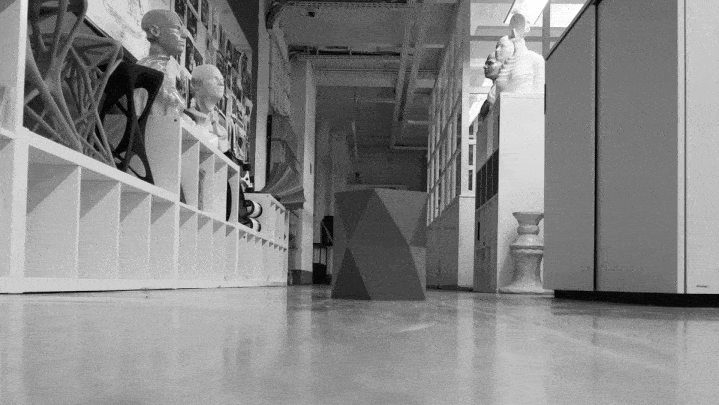
It all began with garbage – well, specifically a lack of desk-side recycling receptacles in the BigRep office, that is. Mirek Claßen, industrial designer and architect at BigRep, was on the hunt for more wastepaper bins in BigRep’s Berlin office, and when he saw a few more were needed, he did what many of us would do: he looked online to find some, and saw Amazon’s range available for same-day delivery. But simply ordering some for delivery wouldn’t have been as fun as Claßen’s next idea. “I thought, why not print one, but make it more beautiful, customizable and very print-friendly,” he said. “The idea for the Kinky Korb was born – a recycle bin that fulfils your office needs.”
Named for its quirky shape and the German word for ‘basket’, Claßen designed the Kinky Korb to be sturdy, aesthetically interesting and a fast-print object. “The recycle bin can be printed in vase mode and is tandem machine ready,” explained Claßen. “So, it has a print time of 2.5 hours per item and I bet that’s even better than Amazon’s same day delivery service!”
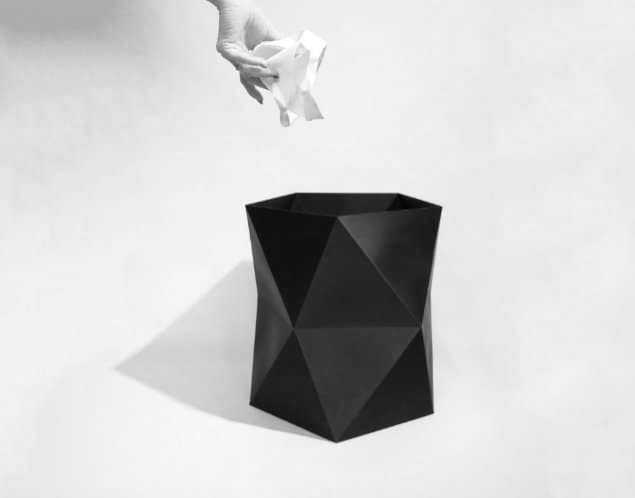
The design works in every color – in fact, the louder the color, the better! BigRep’s PLA filament comes in a range of funky colors, and the Korb is strong and shiny in the Black PRO HT filament as well. Because it is fast to print, incredibly useful and uses a relatively small amount of filament, the Kinky Korb is the ideal project to test out the BigRep range of colors.
When BigRep was asked to bring a little give away furniture piece printed on the BigRep ONE at the ‘Mobility Goes Additive’ event in Frankfurt in November 2017, it created more hype than would usually be reserved for a humble paper basket. Passers-by asked to buy one on the spot. This is how the Kinky Korb made its way to the headquarters of German rail service Deutsche Bahn. BigRep has been partnering with Deutsche Bahn on several research and development projects, including one to print headrests as end-use parts. The company put in an order for some colorful Kinky Korbs for their newly refitted office in Berlin.
So, for a quick side project, there are some lively, colorful results when there is a BigRep printer around. Needless to say, all BigRep staff with the standard-issue wastepaper baskets are vying for a funky new yellow, orange, black or green Kinky Korb!

Mirek Claßen is currently the UX Manager at BigRep, responsible for making software interfaces easy to use and informative. Trained as an architect and working in various roles at BigRep, from innovation design to digital solutions, Mirek applies a creative spirit to all things 3D printing.
Brian Lilley 3D Prints Ecological Solutions: Insights from a BigRep Innovation Award Jury Member
Nova Scotia-based architect Brian Lilley is fascinated by how architecture, ecology, computation and art weave together to create solutions for communities. Now calling Halifax home, the architecture professor has honed his craft in cities such as London and Berlin, and since beginning to teach fulltime has had a focus on the potential of 3D printing. When he first began lecturing at Dalhousie University, Brian was responsible for forming a rapid prototyping lab with laser cutters, CNC milling, and depositional printers. He has worked on many collaborative projects with digital makers and thinkers across North America and Europe, one of which eventually resulted in a prototype ceramic printer.
As a jury member for the BigRep Innovation Award, we asked Brian more about his work background and for his take on integration of computation and 3D printing into design – specifically, furniture design.
Could you please tell us a bit about your background and experience as a designer?
My formative experience in Design was in London, at the Architectural Association, where exceptional projects are the expectation. Computation was just coming into play. My Tutors, Nigel Coates and Daniel Weil, both had young design firms that specialized in furniture and smaller-scale architecture.
Then, working in Berlin with sauerbruch hutton architekten, we employed a sophisticated colour sensibility meshed together with a progressive set of environmental strategies. My major project was the GSW headquarters building, including furnishing for the gardens, restaurants, and conference rooms. The use of computation as a design tool really began with forays into physical simulation (with Arup Engineers), augmented reality, and animation.
Most recently I have been working with a group named 'Narratives in Space and Time' on a series of projects related to the 100th anniversary of the Halifax Explosion. A collaborative approach resulted in an iPhone app called 'Drifts' meant to encourage story-sharing, and the 'Pyschogeographer's Table', a milled topographic tabletop that incorporates both augmented reality projections above and real physical artifacts in drawers below. Another project for the Maritime Museum of the Atlantic has focused on a digital-material-craft reproduction of a key artifact; a panel from the RMA Titanic's first-class lounge area.
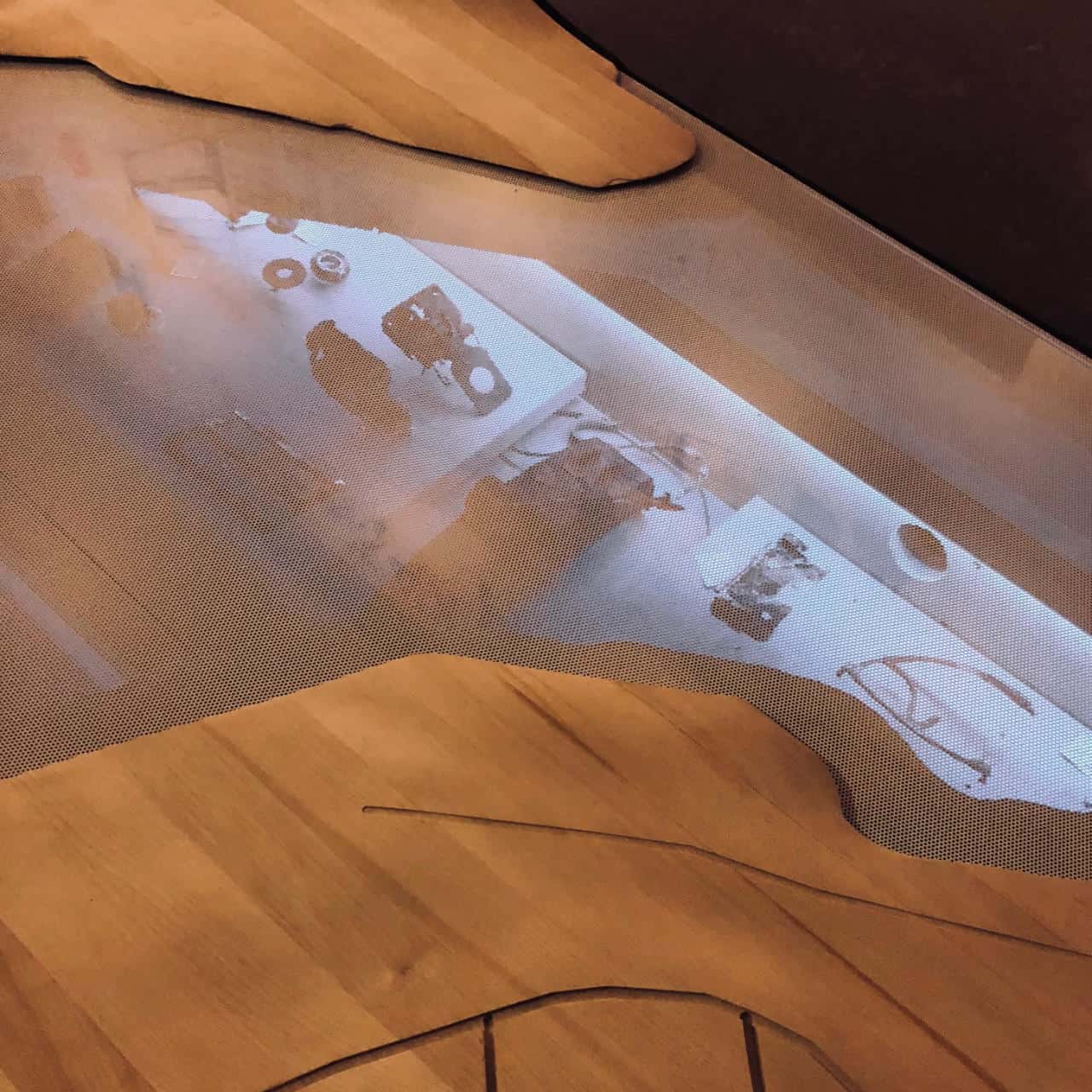
You reference the Joris Laarman Lab as a key inspiration. What specifically about their approach to digital technologies and furniture design do you recommend for aspiring student designers?
Joris Laarman works in a clever way that stimulates design ideas across a range of possibilities involving character, material and production. Fabrication technologies are queried in a way that cross-pollinate with cultural expression and design constraint. For example in an iterative design series, the 'Diamond Chair' (2014), it is materially re-imagined as a magnesium mesh, a walnut maze pattern, and ultimately as a set of puzzle pieces that require assembly. His 'Soft Gradient Chair' exploits postural flexibility with a thermoplastic polyurethane mesh. A further development, the 'Adaption Chair', fuses copper plating onto a 3D-printed polyamide form. His work has been hailed as a masterpiece of digital design by the Cooper Hewitt Museum in New York.
Given the potential of large format 3D printing what do you see as the major impact for designers as it relates to structure, design and ergonomics?
From my experience, three things spring to mind: firstly, the possibilities for exploration of form and character that (perhaps) need to be tempered by concerns with materiality + elegance. Secondly, the exploration of a 'Monolithic' sculptural approach and/or the consideration of the joint detail – in allowing combination with other materials or the potential flexibility of moving parts. Thirdly, in combination with smaller prototypes, the ability to simulate a design and test aspects of both structure and ergonomics in an iterative way.
As an educator and designer, what news sources, blogs or publications do you devour for inspiration and industry news?
Certain designers and artists, for example Ross Lovegrove, Olafur Eliasson and Mark Goulthorpe, have always piqued my interest, especially in relation to architecture. The digital design communities that I value include ACADIA and Smart Geometries, for the integration of scholarship, computation and making. Social media input is sometimes useful (and sometimes not!), such as Instagram, for exposure to new ideas.
Learn about Brian Lilley’s fellow jury member Lindsay Lawson and her approach to creating art using 3D printing technology. Read here an interview with two other BigRep Innovation Award jury members, Amir Fattal and Gregor Ash, about their approach to designing furniture for 3D printing. Full competition details, including the entry form, can be found here.

Brian Lilley, Dalhousie School of Architecture. BigRep Innovation Award Judge
Connect with Brian on Linkedin HERE.
Filling in the Filament Blanks
To truly harness the potential of FFF (commonly known by its trademarked name, FDM) technology, a few things need to fit together in a neat puzzle: the hardware (the machine) needs to work tirelessly and with accuracy; the software must function seamlessly; the 3D printer materials need to be of high quality and suit the nature of the print project. For industrial 3D printers, the stakes become higher when printing large-scale objects for either prototyping or end-use. In these situations, the printing time is longer and therefore printing failures can waste valuable time and money.
To ensure this triad of quality is complete, and that its high standards for hardware, software and innovation are complemented by the best printing materials, BigRep develops its own 3d printer filaments for its large-scale printers. We toil over a new generation of high-thermoplastic materials that are suitable for industrial applications. Only when 3D printers and materials are developed side by side, can it be possible to ensure optimal stability and high quality results.
Over the coming weeks, we will dive deeper into each kind of filament that BigRep produces to learn more about their mechanical properties, possible applications and share some tips and tricks on how best to use and post-process them to achieve superb large-scale parts.
We marry up German machinery with self-developed dedicated thermoplastics, offering a powerful solution for producing large objects for both concept and functional prototyping. Innovation is central to the BigRep philosophy, so there are numerous R&D projects currently running to develop exciting new filaments for its materials portfolio, which currently includes:
BIGREP PLA
Perfect solution for prototyping, art projects, producing end-use parts and rapid tooling applications. This filament extrudes very well and has very low moisture absorption.
One example of how BigRep PLA can be used was demonstrated by BigRep customer Geiger, with its concrete casting formwork. Our e-book on this use case provides further details on the use of this filament for a complex building restoration.
Our experts with +25,000 hours of experience in industrial 3D printing are waiting to sink their teeth into your unique and challenging use case.
BIGREP PETG
PETG is characterized by its strength, toughness and thermal resistance, as well as very low warping behavior – it is a real alternative to ABS.
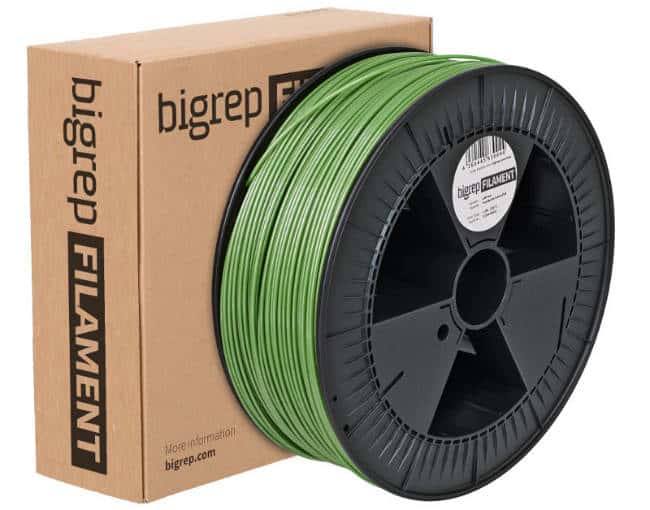
BIGREP PRO HT
In the BigRep PRO HT (HT = high temperature), users have a high-performance filament as an ABS alternative that can easily be used in low-temperature printers, providing even better thermal and mechanical properties.
Check out all BigRep filaments
BigRep Partners with Trideus to Offer Large-Scale Additive Manufacturing Solutions in Benelux
Home » » Page 10
BigRep, a leading German manufacturer of professional large-scale 3D printing solutions, announced today that it has reached an agreement with Trideus, a leading provider of additive manufacturing solutions, to resell BigRep products in the Belgian, Dutch and Luxembourgish region of Benelux.
Founded in 2013 in Lummen, Belgium, Trideus started out with the goal of making 3D printing accessible to end-users. Over the years, as their experience grew, they upgraded their portfolio with only the leading brands and technologies in the industry. With this, Trideus diverted its focus towards offering professional yet affordable additive manufacturing solutions. In the Benelux region, Trideus is the leading supplier of additive manufacturing solutions, products and services.
“We are very excited to be partnering with BigRep,” says Jesse Buteneers, CEO of Trideus. “With BigRep as a partner, we can offer our customers the opportunity to print large, high quality yet affordable 3D printed parts. This type of capability perfectly meets the demand of progressive companies in our region.”
“We are very glad to be joining forces with Trideus, one of the leading 3D resellers in Belgium,” said Ingolf Nachtigall, BigRep’s EMEA Sales Director. “We are looking forward working with them to strengthen our presence in this area.”
About BigRep:
BigRep is a technology start-up based in Berlin with offices in Boston, New York and Singapore, which develops and manufactures the world's largest 3D printers. One of the ground-breaking developments of the company founded in 2014 is the BigRep ONE, which is supplemented by the smaller BigRep STUDIO. Interdisciplinarity and well-founded experience in the field of additive manufacturing characterizes the multinational team of BigRep, now comprised of more than 90 employees. In addition to new products, the Berlin company is now concentrating on complete solutions for industrial customers in the form of integrated additive manufacturing systems. The goal of the highly innovative engineering company is to revolutionize design, prototyping and industrial production from the ground up.
For further information as well as pictures and video material please contact:
Maik Dobberack
PR & Communication
BigRep GmbH
T +49 (0) 30 208 4826-38
E [email protected]

